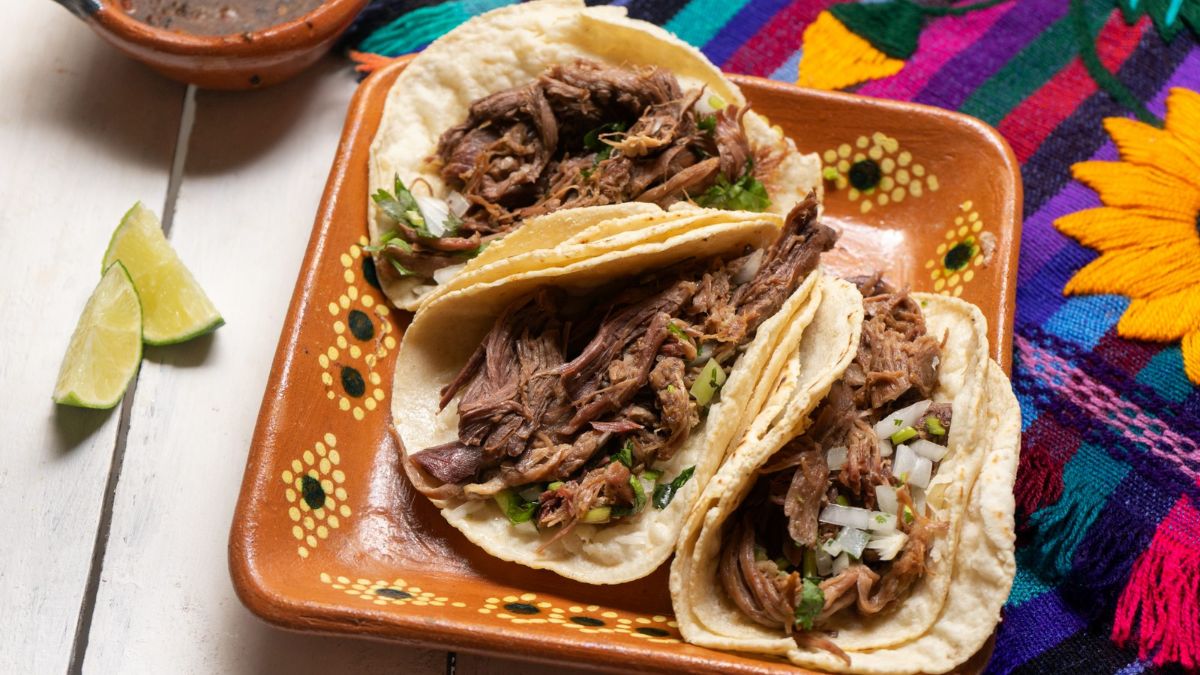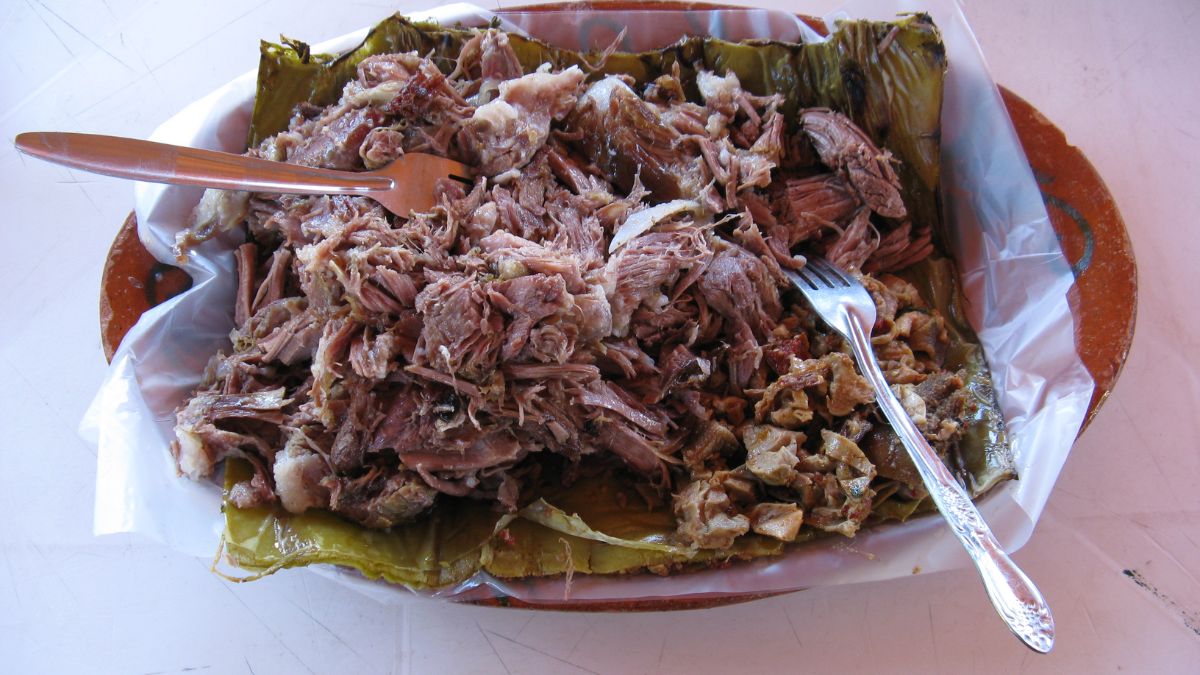Most people in Mexico know that “barbacoa” means meat, usually whole lamb, mutton, or goat, cooked over an open fire or, more traditionally, in a fire pit covered with agave leaves. In this more traditional way, you start by putting a grill over a pot with a little liquid in the fire pit (like water or pulque, an alcohol distilled from the sap of the maguey plant). The meat is grilled and wrapped with maguey leaves.
The pit is then sealed with a lid. While the meat is roasting, it is steamed and braised in its juices, and the maguey leaves add flavor. Because of this, you end up with meat that is so tender it falls off the bone. Depending on the location, the meat is simply seasoned. So eating barbacoa on a tortilla with salsa is a significant part of it.
What is Barbacoa?
The word “barbecue” comes from the Spanish word “barbacoa.” There is a difference between the words barbecue (Barbacoa) and grill, just like in English (parrilla). The Caribbean’s Taino tribe invented Barbacoa, even though most people think it’s Mexican.
Many food historians agree that all barbecue in the Americas is related to this cooking style. It usually means cooking meat over an open fire, keeping it far away from the flame so that it cooks slowly and gets the flavor of the burned wood.
Mexico has barbacoa everywhere. Authentic Mexican Barbacoa features meat— typically lamb but sometimes beef or goat—wrapped in banana or agave leaves and slow-cooked over an open flame or in an underground oven lined with hot coals. The result is tender, shredded meat that melts in your mouth.
Barbacoa is usually served at major gatherings or restaurants that start cooking the night before. Still, you can also incorporate it into quesadillas, burritos, and nachos. Barbacoa’s slow cook time makes it ideal for leaner, tougher, traditionally less expensive cuts like beef cheek, chuck roast, and brisket.
Barbacoa became a way of cooking in Mexico, where meat is cooked slowly in a hole dug in the ground and covered with agave leaves. This makes it similar to other ways of cooking, like pachamanca in Peru and kalua pork in Hawaii. In the original Caribbean Barbacoa, the meat is cooked outside in the open air. But the meat is cooked in a sealed pit, steams, and has a smoky flavor.
Barbacoa is usually saved for special occasions or served at establishments where the cooking process begins the previous evening. Because of this, many home cooks in Mexico and all over the Diaspora have taken Barbacoa and turned it into a pot roast. But that’s where the similarity stops. Not only is it cooked and served differently, but it is also seasoned differently.
How to Make Barbacoa?
If you want to make Barbacoa at home, you don’t have to dig a hole in your yard or find fresh agave leaves (although that would be quite impressive). Many Mexican home cooks have devised clever ways to make Barbacoa on the stove or in the oven. You can also make Barbacoa in a slow cooker; some recipes use a pressure cooker to save time.
1. Marinate your Meat
Once you find your favorite marinade recipe, rub it hard into the meat and cover every inch of the surface. The more flavorful your Barbacoa will be, the longer you let the meat marinate. Marinating for 24 hours is best, but leaving your meat to marinate for a little longer is also fine.
2. Line your Cooking Vessel with the Leaves
3. Add the Marinated Meat and Slow Cook
Ingredients
- 3 pounds beef chuck roast (fat trimmed), cut into 2-inch chunks
- Four cloves of garlic, minced
- Two chipotles in adobo sauce, chopped
- 1 (4-ounce) can dice green chiles
- One small white onion, finely chopped
- 1/4 cup fresh lime juice
- Two tablespoons of apple cider vinegar
- Three bay leaves
- One tablespoon of ground cumin
- One tablespoon of dried Mexican oregano (or standard dried oregano)
- Two teaspoons of fine sea salt
- One teaspoon of freshly ground black pepper
- 1/4 teaspoon ground cloves
- 1/2 cup beef stock or water
What Kind of Meat is Barbacoa Made Out of?
US Barbacoa uses chuck roast, brisket, and beef cheeks. But any cut of beef that has a lot of connective tissue and takes a long time to cook until tender works well. Remember that there should be enough fat in the muscle fibers to keep the meat moist while it’s cooking. Even with steam, lean meat will dry up and become stringy if cooked too long.
Barbacoa Seasoning
The barbacoa seasoning is probably the main thing that makes this dish different from other Mexican meat dishes cooked slowly. There are many different ways to make Barbacoa, and each chef has their secret ingredients that make it taste even better. Barbacoa seasoning, applied as a marinade, can cut through strong meat flavours. Still, barbacoa seasoning is potent.
A common way to season barbacoa is with a mix of dried guajillo and ancho chile peppers. Guajillo peppers are mildly sweet and taste almost like dried fruit mixed with black tea. If you’ve ever had black currant tea, they taste a bit like that, but with a smoky, smoldering kick of heat. Ancho chiles have a stronger taste of smoke and a little fruit, and both chiles are not very hot (at least by Mexican standards).
Other common seasonings for Barbacoa include Mexican oregano, which tastes very different from Italian or Greek oregano but will work in a pinch. Many barbacoa seasoning recipes also call for pureed garlic and onions, and many recipes also call for sweet spices like cinnamon, allspice, or a mix of both.
What are the Differences Between Barbacoa and Birria?
People who don’t know much about Mexican food can sometimes mix Barbacoa and birria. Birria and Barbacoa are similar but have several important variances. First, Mexico offers many styles of barbacoa. Birria, on the other hand, comes from the state of Jalisco, where it is the most famous dish. Birria, cooked differently in various parts of Mexico, is also popular.
Both birria and Barbacoa start with the same way of cooking: putting hot coals or firewood in a hole dug in the ground. Barbacoa uses agave leaves to line the pit and meat alone. Birria involves putting meat in a pot with sauce, sealing it with tortilla bread, and putting it in a pit. You’re done after barbacoa. But birria needs an extra step: roasted tomato purée is added to the pot of sauce and meat, and the whole thing is simmered again.
Barbacoa is usually juicy without soup or sauce. Instead, the juices are part of the side dish you eat as a consomé. Birria, which has more liquid, is served in a bowl. Birria hails from Jalisco, where people eat more goat meat than beef.
What to Serve with Barbacoa Beef?
Traditionally, Barbacoa is served with fresh corn tortillas, freshly chopped onions, and cilantro. The onions and cilantro give the rich, strong flavors of the meat a sharp, herbaceous contrast. Add lime juice and tangy hot sauce for extra heat.
Northern Mexico, notably Chihuahua, puts barbacoa in tortas and Mexican-style sandwiches. Tortas are made with bolillo rolls. But you can make a torta with any crusty water roll. You can use kaiser rolls or ciabatta buns in a pinch, but make sure the bread is sturdy enough to hold up to the juicy meat filling. Onions, cilantro, refried beans, avocado, lettuce, cabbage, and refried beans are common things to put on a torta. But you can change your torta in any way you want.
Barbacoa can also be a filling for burritos, enchiladas, and quesadillas, among other Mexican dishes. If you like crunchy tacos made in the American style, Barbacoa is a great addition and a nice change from the usual ground beef. It makes casseroles, empanadas, pasta, and rice.
Conclusion
In the US, barbacoa usually uses beef. Mexico makes barbacoa with beef, goat, lamb, or mutton. Southern Yucatan has pork-based Barbacoa called cochinita pibil. You can get Barbacoa anytime or night in restaurants and taco stands all over Mexico and the rest of the world. On the other hand, Barbacoa is not something that most people cook for a quick weeknight meal. It takes a lot of work, and it’s a dish that a whole family or community often makes for holidays or celebrations. Late night or early morning preparation allows it to roast for hours and be ready to eat by lunchtime.

